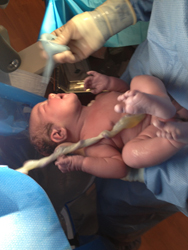Sight is one of the major ways we interact with our environment, learn and develop. There are many ways a child’s vision can be damaged and most of them are from processes that could go unrecognized until severe damage has occurred. It is for this reason that the American Academy of Pediatrics has developed guidelines for vision screening that will help pediatricians identify problems before they become severe.
Your baby receives his first vision screening before leaving the hospital. At birth, infants are born with very poor vision and are only able to see shadows and shades of grey. Because of this, your doctor’s initial exam doesn’t focus on how well your baby sees, but looks for structural abnormalities that could affect normal visual development.
At your child’s first few check-ups, in addition to visually inspecting your child’s eyes, your doctor will ask about milestones they should be meeting. Between six and nine weeks your baby will be able to fixate on a person or object. At around three months of age they will begin following things with their eyes. By four months they begin to develop depth perception and are able to focus more clearly on an object. If your baby is not meeting these milestones, your doctor may elect to refer you to a pediatric ophthalmologist for further evaluation.
At six months of age your pediatrician may begin asking if you ever see your baby’s eyes cross. Occasional crossing can be tolerated, but if it becomes persistent, a referral to an ophthalmologist will be required. Eye crossing – or strabismus – can lead to vision problems. To prevent double vision, a child’s brain will suppress the input from the crossed eye. With time, the suppression from the crossed eye can become permanent, leading to vision loss in that eye. This condition is called amblyopia. If you notice that your child’s eyes cross make sure you mention this to your pediatrician.
Around three years of age most kids have developed enough to begin formal visual acuity testing. Cooperative kids will be asked to cover an eye and look at different sized shapes on a chart. At this age, vision of 20/50 or worse should be referred to an ophthalmologist. Also at three years of age, your doctor will be able to use a fundoscope to examine the back of your child’s eyes. Strabismus (eye crossing) is still a concern at this age, so any concerns should be discussed with your doctor.
As children develop further, the eye charts become more accurate and they are asked to read numbers and letters. At five years of age, vision of 20/40 or worse should be referred to an optometrist. Children older than five with 20/30 or worse should be referred. Your doctor should check your child’s visual acuity every year, as well as examining the exterior and back of your child’s eyes.
Besides your pediatrician, many schools do regular vision screening. In between examinations, it is important to watch your child for changes in their vision. Vision problems in older children can present themselves as chronic headaches, school difficulties, or problems in sports. If you ever have concerns about your child’s vision, call your pediatrician. Or for advice from a phone nurse, or for help finding a pediatrician, call the St. Louis Children’s Hospital Answer Line at 314.454.KIDS.





One of the main reasons that have led to the failure of other diet plans when compared
to HCG weight loss drops is that in HCG diet plan, there is no chance that a patient will
feel hungry because along with 500 calories a day, the patient is only allowed
to have high protein meals with rich fiber food which is why the
patient won’t feel hungry and in fact they feel contented all day.
In such an altered phase it is essential that we give importance to our body so that we
can have a long and happy life. You can have a look at them and then decide whether
to choose one for you or not.
American Journal of Physiology-Regulatory, Integrative
and Comparative Physiology recently published a report that connects hypertension and obesity.
When the time comes to purchase HCG the very first time, making the
effort to look, to check, and also to research prices and shipping costs is needed.
Tacoma HCG weight loss has become the first choice of many Physicians and individuals seeking
permanent weight reduction.